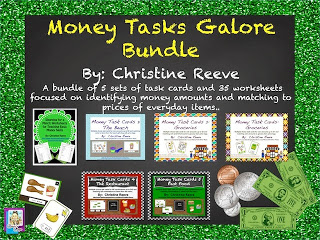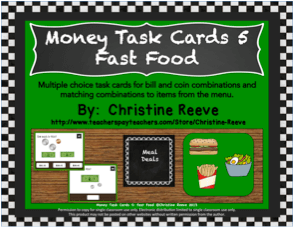Sharing is caring!
Taking a brief break from IEP goals (my brain couldn’t handle it tonight), I thought I would write about something that came up for a great kiddo I was working with the other day. He is great with identifying amounts of money and identifying the right amount of money when asked, but he doesn’t really understand what money means. He doesn’t understand the need to earn it and exchange to buy things. So I thought I would share some of the ideas I’ve used over the years to teach this skill.
1. Instruction with Task Cards
The picture to in the title is from my latest set of money task cards. Each set of task cards has cards with items with prices. They have different themes like the beach shop, grocery store and restaurants. These cards are designed to be used so that the students can match the cards that have the money combinations on them with them. But they can also be used in individual or small group instruction to have the student purchase the cards by giving real or pretend money to help them understand the beginning of the exchange.
2. Have the student purchase reinforcers.
This can be done in a few ways. I would start by giving the student a set of money and making a price list (for activities) or price tags (for items) of how much money is needed to purchase the reinforcer. For instance give him 5 $1 bills and have the prices be $2 or $3 (or $1 per minute for computer time or other activities). Then have him give you the money and he gets the reinforcer. Practice this with different amounts of money to get him used to it. This builds a reinforcer into it naturally. If he gives you the right amount of money he gets the thing he wants. As he gets good at this skill, you could start having him earn money from school jobs or as part of a token economy and then use that money to purchase desired activities. Lots of classrooms use a school store in this way as part of their token economy behavioral system.
3. Set up a grocery store in your classroom.
Bring in empty containers and put prices on them. Then have students buy the items on a list or for a recipe, choose those things off the shelf and figure out how much money they need to make the purchase. You can easily differentiate this by having some students’ list have one item while others have multiple. Some students could have whole dollar amounts and others could have bill/change combinations and some students could have to make change. Students could even be the cashier and have to make change.
4. Set up a restaurant in your classroom.
Turn your snack time into a restaurant. Make a menu with the available food items for snack and put prices on them. Then have students determine if they have enough money to buy what they want for snack (that they earned or you gave them to start with). Have a student serve as a waiter–this is a great way to have kids communicate with each other and figure out the check, write down the amount and give it to the customer. There are a ton of skills you can build into this. Program voice output devices for nonverbal students so they can choose what they want and ask for it. You can set it up as a fast food restaurant where they have to wait in line, or a sit-down restaurant where they wait for their food to be served, or any other type depending on your students. This gives money menacing and again links it to something reinforcing for the student.
5. Community-based Instruction.
Never forget the step of community-based instruction. After students practice these skills in the classroom, take them to a restaurant or a grocery store and have them choose something to purchase and figure out if they have enough money. This is something that young children might do on a field trip occasionally but that middle and high schoolers might do weekly or more often as part of their regular curriculum to assure they can become fluent in navigating and using community services. With the holidays coming up, have students grocery shop to make a Thanksgiving feast or go to a store to buy presents for family members. Those are great opportunities to make sure that the money skills generalize beyond the classroom.
For the task cards, I talked about above, check out Money Task Cards 5: Fast Food. To check out all of my money task cards (not including next dollar skills) and worksheets, you can check out the Money Tasks Galore bundle for the links to the individual products and check out the previews.










